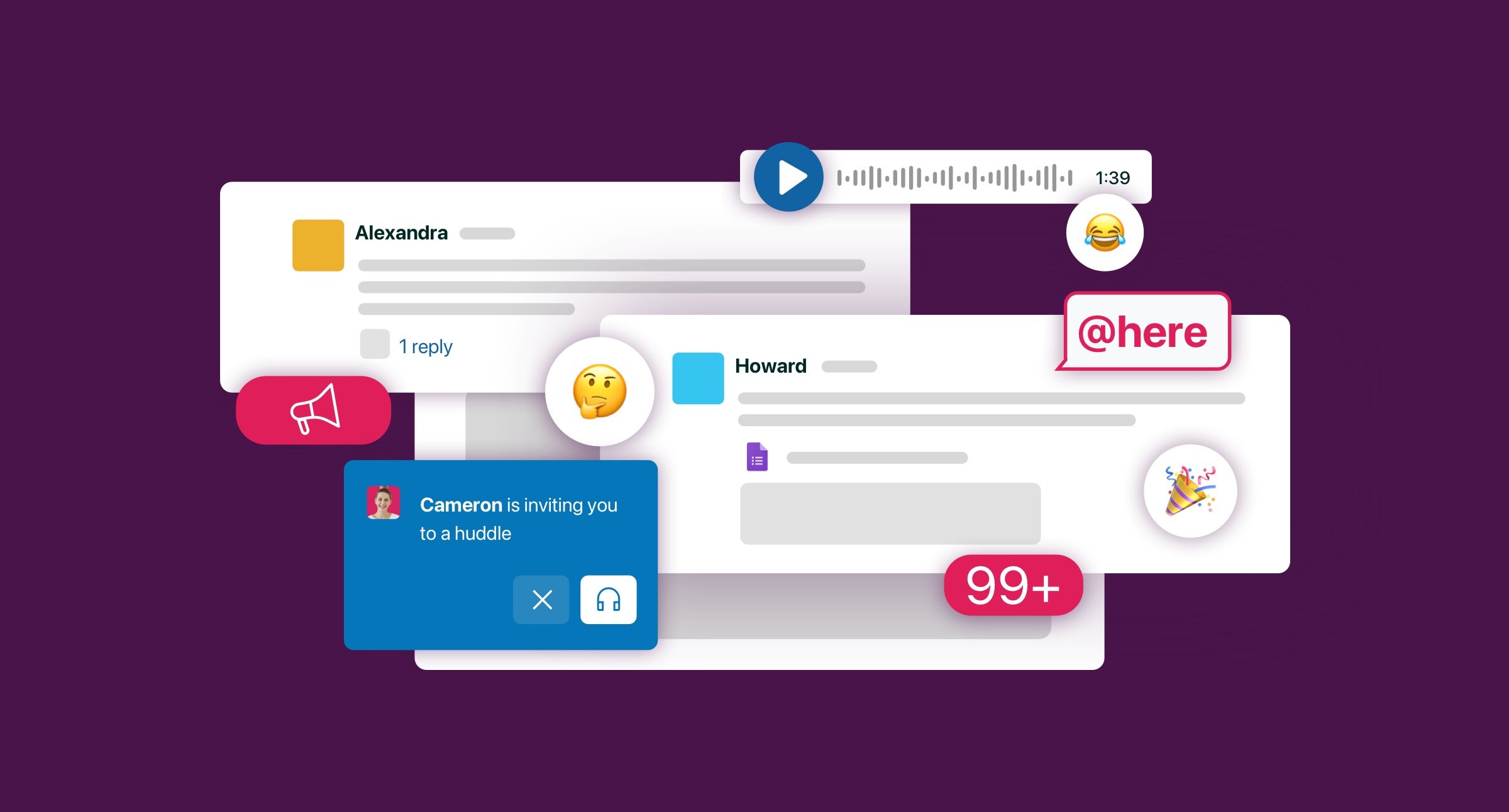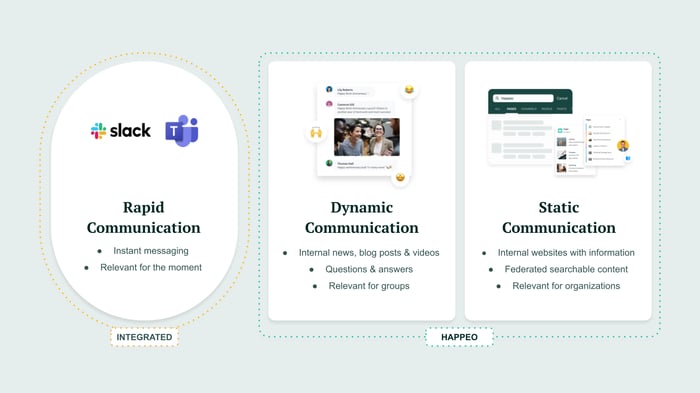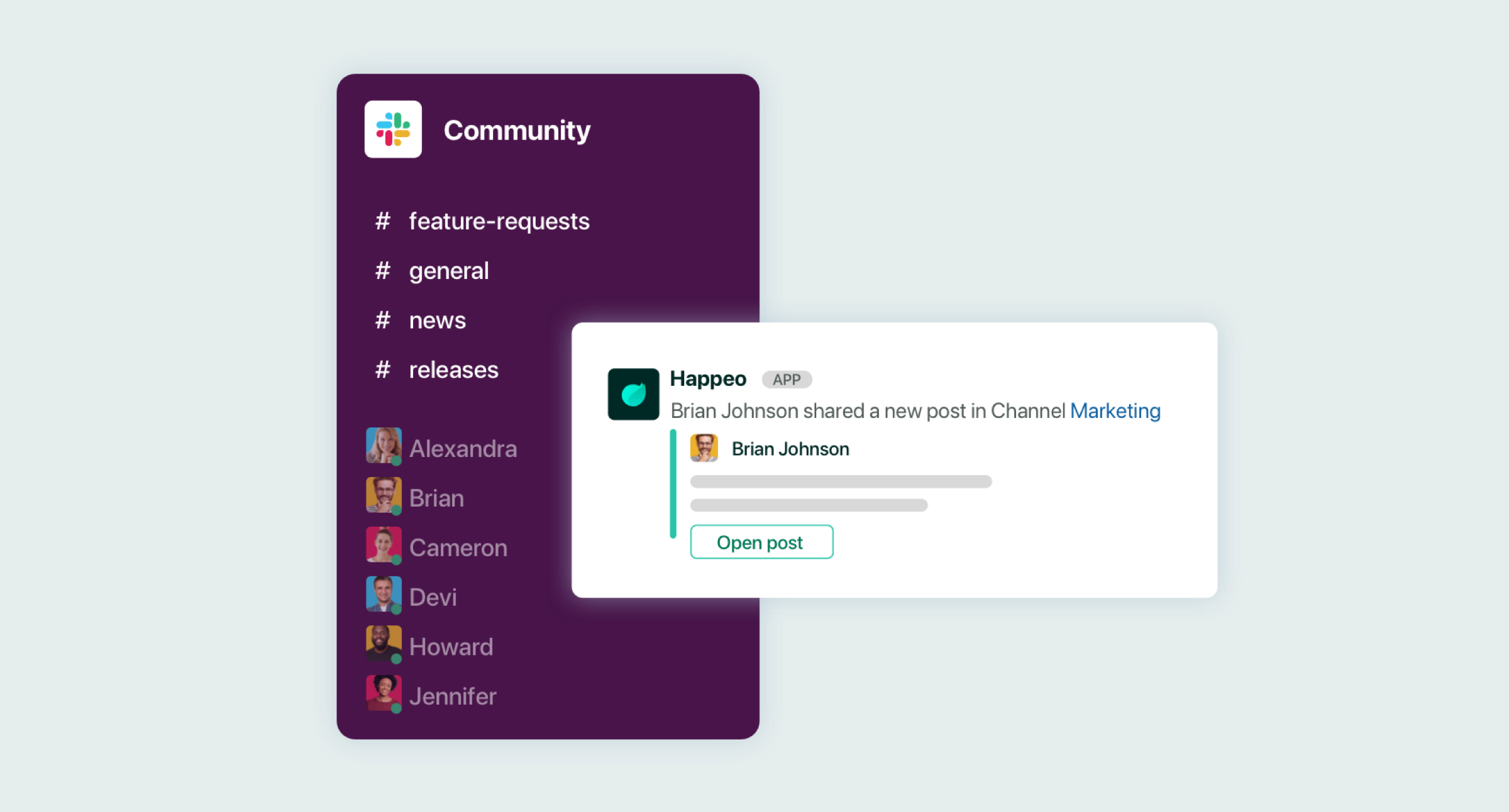
Quick guides Productivity
Help your team avoid distractions on Slack: Our best practices

9 mins read
Start building your digital home with Happeo
Request a demoQuick guides Productivity
Platform
Use cases
Solutions
Happeo for
Resources
Explore
Support
Available now
Use Cases
Capabilities
Happeo For
Comparisons
Explore
Support
Recent

Madina Baikulova
9 mins read
Do you ever wake up to such a mountain of Slack notifications that you feel overwhelmed before your day’s even started?
You’re not alone. More than 12 million people use Slack every day, and we’re willing to bet that a good portion of them have experienced Slack burnout at one time or another.
That’s not to say that Slack isn’t a useful tool — or even an enjoyable one. 85%* of Slack users love using the platform, and for good reason. It’s a hugely convenient way to keep in touch with colleagues from a distance, and it’s one of the most popular instant communication tools out there.
But here’s the thing: Slack can also be a big productivity suck. Constantly pinging channels are hugely distracting, and — as you’ll know if you’ve ever taken a few days off without checking Slack — notifications can build up at an incredible rate. Plus, since it’s such a busy platform, important messages can easily get lost in the noise.
The fact is that Slack is an instant communications channel, designed for quick discussions and water cooler chat — and it’s really not suitable for business-critical updates or long-form content.
If you want a well-rounded comms solution, you’ll need to add a tool that can work alongside Slack, helping you to manage your announcements, news, and updates while bringing Slack back to its true purpose: instant communications.
Once you have that in place, Slack can be an extremely useful tool for communicating with colleagues, and doesn’t have to suck away your time or create an “always on” culture that means employees never get to clock out — you just have to use it right.
In this article, we’ll share our tips for managers and leaders to help their teams to get the most out of Slack, without it becoming a productivity killer.
Slack can be a noisy place. And a big reason for that is that it’s often overused: many companies use Slack for all of their communications — which can quickly get overwhelming.
To take back control of communications in your organization, you need to separate out your rapid, dynamic, and static communications. Slack is an excellent solution for rapid communications: the whole point of the platform is to enable employees to quickly ping a message across to a colleague in the same way they might have popped over to their desk pre-2020.
“Slack is perfect for short-form communications,” says Frank van de Koppel, Strategy Director at rethink.
“In my experience, it can almost entirely replace the IRL communication in the office. Long-form communication, on the other hand, is quite tricky. Many don’t have the attention span to read email-length Slack messages.”
This means that it’s also important to have a space where employees can store and find longer-form content — without spamming everyone with notifications or having to search through months of messages.
A company intranet can help you to reduce messages on Slack and bring together disparate sources of information so employees always know where to look for long-form, long-lifespan content like budget reports, marketing plans, or office policy documents.
You can also use your intranet to share dynamic, mid-lifespan communications: those that don’t need to last forever but don’t belong on Slack either — like internal news or blog posts, or company-wide messages from your senior leadership team. These might be broadcast to the whole company, or to a group of employees within the organization.
With that clutter cleared, you can get back to using Slack for what it was designed for: rapid, short-lifespan messaging that’s relevant in the moment, but doesn’t need to be referred back to down the line.

Plus, certain intranet solutions (like Happeo) even integrate with Slack — so you can use them together for a seamless rapid, dynamic, and static communications experience.
A lot of Slack’s problems come down to the way it’s used or configured — and a few quick tweaks can transform how you and your team experience the platform.
Here are a few tips to share with your team:
Large organizations tend to have a lot of channels, for everything from specific teams to defunct projects to photos of employees’ pets. And over time, most of us end up in more channels than we could possibly keep up with.
Employees should feel absolutely free to duck out of any channels they don’t need to be in — so they don’t miss messages in the ones that are actually useful.
Employees are often bombarded with Slack messages and notifications that aren’t relevant to them. To resolve this, always reply to messages in threads. This way, you’ll only send notifications to the people who have commented on the thread, leaving everyone else to get on with their work.
And if a thread goes on too long? Unsubscribe! Quitting threads that you’re no longer involved in is another way to reduce distractions on Slack.
Slack notifications can completely derail your focused work time, so it’s important to set them up so you only see the ones you need. When choosing what actions you’d like to be notified about on Slack, you have three options:
As a minimum, we’d recommend choosing the second option so you’re only notified when something’s actually relevant to you. But opting for “nothing” is also a valid choice, which allows you to completely eliminate distractions from Slack, and simply pop in and respond to messages on your own time.
Slack has a lot of features that many users aren’t aware of. For example, did you know that you can easily save a message to return to later if you don’t have time to respond? To do this, simply hover over a message and click the save icon.
Then, you can view all of your saved items by clicking on ‘Saved’ in your sidebar — and use them as a to-do list. You can even ask Slack to remind you of a message at a more convenient time.
Most jobs require you to really get your head down and focus once in a while — and Slack is one of the biggest culprits for interrupting deep work. Leveraging your status to let colleagues know you’re away from Slack can be a game changer here. For example, consider setting your status to something like:
It’s important that you actually close Slack once you’ve changed your status, as people will likely still send you messages expecting a response later on, and you don’t want to be tempted to interrupt your flow by checking for new messages.
If you want to help your team minimize distractions on Slack, it’s a good idea to work with them to put together some basic policies for using the platform. Some of this is simply about encouraging everyone to implement the tips above. For example, you might want to make it a policy for everyone to reply in threads so that no one is overwhelmed by notifications.
Here are a few other Slack guidelines that you could implement to make everyone’s lives easier:
Channels quickly build up, and it's inevitable that some will fall into disuse after a while. This can create a lot of clutter for employees, who’ll still see these inactive channels in their sidebars.
For this reason, it’s a good idea to set a policy for when channels will be deleted — such as after six months of inactivity.
The emoji reaction feature can help employees to avoid getting sucked into long conversations on Slack. However, it’s a good idea to make sure everyone’s on the same page by clarifying what certain reactions actually mean.
For example, you might use the thumbs-up emoji to indicate approval, but people sometimes expect a text reply as well. You can save your employees time by clarifying that they don’t need to wait for a message from you if you’ve already sent this reaction.
Slack is infamous for creating an “always on” culture, where people feel pressured to respond to messages straight away, even when they’re not at work. To help your employees switch off and avoid burnout, you should encourage them to turn off their notifications outside of their office hours — or even make this a company policy.
You can easily set a recurring schedule in the “notifications” section of your preferences, and notifications will automatically be deactivated at the end of each work day. Leading by example is key here: if employees see that management and leadership don’t respond to Slack out of hours, they’ll understand that they don’t have to either.
If you’ve ever taken a vacation without checking Slack (and we hope you have!), you’ve probably come back to a whole bunch of notifications. The thing is, those messages are probably no longer relevant, especially if you’ve been away for a week or more. But most people still feel compelled to read through everything and find out what they’ve missed — which can be a huge time suck.
We suggest implementing a simple policy wherein everyone agrees to clear all of their notifications when they get back from time off. There’s a secret Slack hack that you might not know about that can come in useful here: simply hit Shift + Esc to mark every message as read.
As we’ve said, Slack is a great tool for instant communications — but it’s not suited to long-form content or sharing information that employees might need to return to again and again. In some organizations, Slack is also just too busy for business-critical updates, since they can easily get lost.
To use Slack effectively, companies need to have clear guidelines on what should go on Slack, and what should be kept on other platforms. For example, back-and-forth discussions about the best direction for a project might work well on Slack, since the platform is designed to replicate an in-person conversation. However, static content like company guidelines or project updates, or important, company-wide updates from leadership might work better on another platform.
Ensuring employees know what content they should use Slack for helps to keep the platform free of noise and avoids bombarding everyone with notifications.

Slack can be a valuable tool for an organization, but it needs to be used properly. If not, it can easily become a distraction, suck away at your team’s productivity, and pressure them into working when they’re not on the clock.
You need to make sure you have a complete comms toolkit that includes a space for instant messaging (Slack), and a dedicated platform for important company-wide announcements and static information that might otherwise get lost.
The good news? Thanks to Happeo’s integration with Slack, you can get the best of both worlds, combining powerful instant communications with dynamic intranet features for a smooth and seamless comms experience that brings order to information chaos.
Want to learn more? Head to our page on how Happeo and Slack work together to transform communications and knowledge management in your organization.
*The Slack statistics on this page come from Happeo’s survey-based research performed in July 2022 (N=300)
